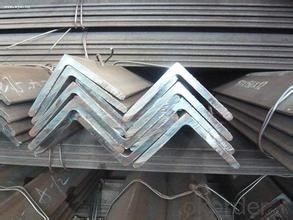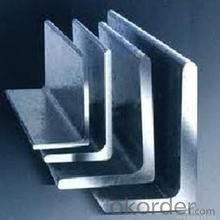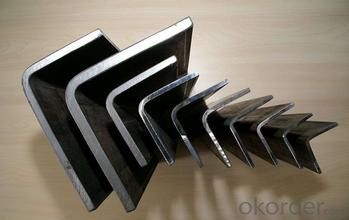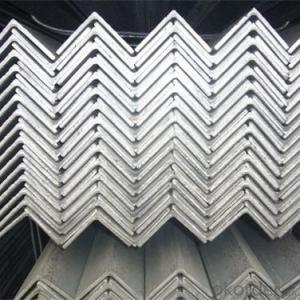Hot Rolled Small Angle Rolling
- Loading Port:
- Tianjin
- Payment Terms:
- TT or LC
- Min Order Qty:
- 25 m.t.
- Supply Capability:
- 2000 m.t./month
OKorder Service Pledge
OKorder Financial Service
You Might Also Like
Product Description:
OKorder is offering Hot Rolled Small Angle Rolling at great prices with worldwide shipping. Our supplier is a world-class manufacturer of steel, with our products utilized the world over. OKorder annually supplies products to European, North American and Asian markets. We provide quotations within 24 hours of receiving an inquiry and guarantee competitive prices.
Product Applications:
Hot Rolled Small Angle Rolling are ideal for structural applications and are widely used in the construction of buildings and bridges, and the manufacturing, petrochemical, and transportation industries.
Product Advantages:
OKorder's Hot Rolled Small Angle Rolling are durable, strong, and resist corrosion.
Main Product Features:
· Premium quality
· Prompt delivery & seaworthy packing (30 days after receiving deposit)
· Corrosion resistance
· Can be recycled and reused
· Mill test certification
· Professional Service
· Competitive pricing
Product Specifications:
Manufacture: Hot rolled
Grade: Q195 – 235
Certificates: ISO, SGS, BV, CIQ
Length: 6m – 12m, as per customer request
Packaging: Export packing, nude packing, bundled
Chinese Standard (H*W*T) | Weight (Kg/m) | 6m (pcs/ton) | Light I (H*W*T) | Weight (Kg/m) | 6m (pcs/ton) | Light II (H*W*T) | Weight (Kg/m) | 6M |
100*68*4.5 | 11.261 | 14.8 | 100*66*4.3 | 10.13 | 16.4 | 100*64*4 | 8.45 | 19.7 |
120*74*5.0 | 13.987 | 11.9 | 120*72*4.8 | 12.59 | 13.2 | 120*70*4.5 | 10.49 | 15.8 |
140*80*5.5 | 16.89 | 9.8 | 140*78*5.3 | 15.2 | 10.9 | 140*76*5 | 12.67 | 13.1 |
160*88*6 | 20.513 | 8.1 | 160*86*5.8 | 18.46 | 9 | 160*84*5.5 | 15.38 | 10.8 |
180*94*6.5 | 24.143 | 6.9 | 180*92*6.3 | 21.73 | 7.6 | 180*90*6 | 18.11 | 9.2 |
200*100*7 | 27.929 | 5.9 | 200*98*6.8 | 25.14 | 6.6 | 200*96*6.5 | 20.95 | 7.9 |
220*110*7.5 | 33.07 | 5 | 220*108*7.3 | 29.76 | 5.6 | 220*106*7 | 24.8 | 6.7 |
250*116*8 | 38.105 | 4.3 | 250*114*7.8 | 34.29 | 4.8 | 250*112*7.5 | 28.58 | 5.8 |
280*122*8.5 | 43.492 | 3.8 | 280*120*8.2 | 39.14 | 4.2 | 280*120*8 | 36.97 | 4.5 |
300*126*9 | 48.084 | 3.4 | 300*124*9.2 | 43.28 | 3.8 | 300*124*8.5 | 40.87 | 4 |
320*130*9.5 | 52.717 | 3.1 | 320*127*9.2 | 48.5 | 3.4 | |||
360*136*10 | 60.037 | 2.7 | 360*132*9.5 | 55.23 | 3 |
FAQ:
Q1: Why buy Materials & Equipment from OKorder.com?
A1: All products offered byOKorder.com are carefully selected from China's most reliable manufacturing enterprises. Through its ISO certifications, OKorder.com adheres to the highest standards and a commitment to supply chain safety and customer satisfaction.
Q2: How do we guarantee the quality of our products?
A2: We have established an advanced quality management system which conducts strict quality tests at every step, from raw materials to the final product. At the same time, we provide extensive follow-up service assurances as required.
Q3: How soon can we receive the product after purchase?
A3: Within three days of placing an order, we will begin production. The specific shipping date is dependent upon international and government factors, but is typically 7 to 10 workdays.
Q4: What makes stainless steel stainless?
A4: Stainless steel must contain at least 10.5 % chromium. It is this element that reacts with the oxygen in the air to form a complex chrome-oxide surface layer that is invisible but strong enough to prevent further oxygen from "staining" (rusting) the surface. Higher levels of chromium and the addition of other alloying elements such as nickel and molybdenum enhance this surface layer and improve the corrosion resistance of the stainless material.
Q5: Can stainless steel rust?
A5: Stainless does not "rust" as you think of regular steel rusting with a red oxide on the surface that flakes off. If you see red rust it is probably due to some iron particles that have contaminated the surface of the stainless steel and it is these iron particles that are rusting. Look at the source of the rusting and see if you can remove it from the surface.
Images:



- Q:Can steel angles be used for support structures in sports arenas or stadiums?
- Yes, steel angles can be used for support structures in sports arenas or stadiums. Steel angles are commonly used in construction due to their strength, durability, and versatility. They are particularly suitable for support structures as they can withstand heavy loads and provide stability. In sports arenas or stadiums, steel angles can be used for various purposes such as supporting the roof, creating seating platforms, constructing staircases, and forming the framework for walls and partitions. The flexibility of steel angles allows architects and engineers to design custom support structures that meet the specific requirements of each sports arena or stadium. Furthermore, steel angles can be easily fabricated and joined, making them ideal for the construction of complex support systems. Their ability to resist bending, twisting, and compression ensures the overall stability and safety of the structure. Moreover, steel is a sustainable material that is 100% recyclable. This makes it an environmentally friendly choice for sports arenas or stadiums. By using steel angles for support structures, the construction industry can contribute to reducing carbon emissions and promoting a more sustainable future. Overall, steel angles are a reliable and efficient choice for support structures in sports arenas or stadiums. Their strength, durability, versatility, and sustainability make them an excellent option for ensuring the safety and stability of these large-scale structures.
- Q:Can steel angles be used as lintels?
- Yes, steel angles can be used as lintels. Steel angles are commonly used in construction as lintels due to their strength and durability. Lintels are structural elements that support the weight of the wall above an opening, such as a door or window. Steel angles are especially suitable for this purpose because they can bear heavy loads and provide excellent structural support. They are often used in masonry construction to create a strong and stable lintel. Additionally, steel angles can be easily customized to fit specific dimensions, making them a flexible choice for lintel applications.
- Q:What are the different types of connections used for steel angles in steel frames?
- There are several types of connections used for steel angles in steel frames, including welded connections, bolted connections, and riveted connections. Welded connections involve fusing the angles together using heat, creating a strong and permanent bond. Bolted connections involve using bolts and nuts to secure the angles together, allowing for easy disassembly if necessary. Riveted connections involve using rivets, which are metal pins, to hold the angles together by forming a permanent, tight fit. The choice of connection type depends on the specific requirements of the steel frame and the desired level of strength and durability.
- Q:How much is the weight of 40 * 3 angle steel theory?
- The angle iron can be made up of different force components according to the different structure, and can also be used as the connecting piece between the components. Widely used in a variety of architectural and engineering structures, such as beams, bridges, towers, hoisting and conveying machinery, ships, industrial furnace, reaction tower, container frame and warehouse.
- Q:Can steel angles be used for support structures?
- Yes, steel angles can be used for support structures. Steel angles are commonly used in construction and engineering industries for various purposes, including providing support and stability to structures. The L-shape of steel angles allows them to be easily bolted or welded together, making them ideal for creating strong and durable support structures. They are often used in applications such as building frames, roof trusses, bridges, and industrial platforms. Additionally, steel angles offer excellent load-bearing capacity and resistance to bending and twisting forces, making them a reliable choice for support structures.
- Q:Are steel angles resistant to earthquakes?
- Yes, steel angles are resistant to earthquakes. Steel is a strong and durable material that can withstand the forces generated during seismic events. The use of steel angles in construction provides stability and structural integrity, making them a reliable choice for earthquake-resistant buildings.
- Q:Can steel angles be used in the construction of industrial platforms?
- Certainly, the utilization of steel angles in the construction of industrial platforms is viable. Due to their exceptional strength and durability, steel angles are frequently employed in construction ventures. These angles can be easily joined via welding or bolting, thereby creating a robust and steady platform structure. Their utility is particularly evident in industrial arenas, where substantial loads and constant pedestrian traffic are to be anticipated. By providing support and stability, steel angles ensure that the platform can endure the weight and motion of machinery, equipment, and laborers. Furthermore, steel angles exhibit resistance to corrosion, rendering them suitable for deployment in diverse environments, including industrial settings that involve exposure to chemicals, moisture, and extreme temperatures. All in all, steel angles represent a dependable and cost-effective choice for the construction of industrial platforms.
- Q:What's the chemical reaction between stainless steel and galvanized angle iron?
- The essential condition for stainless steel to be corrosion resistant is that the mass fraction of chromium must be greater than 10~12%. When the temperature increases, the diffusion velocity of carbon in the grain of stainless steel is higher than that of chromium. Because the solubility of carbon in austenite at room temperature is very small, about 0.02% ~ 0.03%, and the carbon content in austenite stainless steel are generally more than this value, the excess carbon will continue to austenite grain boundary diffusion, and chromium compounds, compounds of chromium carbide in the crystals, such as 23C6 (CrFe) etc.. The data show that chromium diffusion along the grain boundary activation capacity of 162 ~ 252KJ/mol, and Cr intracrystal diffusion activation energy is about 540KJ/mol, namely: chromium by intracrystal diffusion faster than chromium diffusion along the grain boundary velocity is small, the chromium was too late to grain boundary diffusion, so the main chromium chromium carbide formed in intergranular required not from the austenite grain interiors, but from the vicinity of the grain boundaries, the chromium content makes near the grain boundary is reduced, when the mass fraction of the grain boundary chromium low to less than 12%, the formation of the so-called "chromium depleted zone", in corrosion, will lose the chromium depleted zone corrosion resistance, and intergranular corrosion.
- Q:What are the different types of steel angles available?
- There are several different types of steel angles available, each designed for specific applications and purposes. Some common types include: 1. Equal Angle: Also known as L-shaped angles, these steel angles have equal side lengths and are often used for general structural and construction purposes. They provide excellent support and stability when connected to other structural components. 2. Unequal Angle: As the name suggests, unequal angles have different side lengths. These angles are commonly used in applications where one side needs to be longer or shorter than the other, such as supporting uneven loads or creating specific shapes. 3. Stainless Steel Angle: These angles are made from stainless steel, which is highly resistant to corrosion, making them suitable for applications where exposure to moisture or chemicals is a concern. They are often used in food processing plants, chemical industries, and marine environments. 4. Galvanized Angle: Galvanized steel angles are coated with a layer of zinc, providing excellent corrosion resistance. This makes them ideal for outdoor applications or areas with high humidity or saltwater exposure. 5. Rolled Steel Angle: Rolled steel angles are manufactured by rolling hot-rolled steel into the desired shape. This process enhances the strength and durability of the angle, making it suitable for heavy-duty applications. 6. Slotted Angle: Slotted angles have holes or slots along their length, allowing for easy attachment and adjustment. They are commonly used in shelving systems, workbenches, and storage racks, as they offer a versatile and customizable solution. 7. Structural Steel Angle: These angles are typically used in construction projects requiring load-bearing support. They are designed to withstand heavy loads and provide structural stability in buildings, bridges, and other infrastructure projects. It is important to consider the specific requirements of your project before choosing the appropriate type of steel angle. Consulting with a structural engineer or steel supplier can ensure that you select the right angle for your application.
- Q:Are steel angles resistant to impact or vibration?
- Steel angles exhibit resistance to both impact and vibration. The strength and toughness of steel make it highly resistant to impact, as it is capable of absorbing and distributing the force generated by an impact, thereby preventing any structural damage. Additionally, steel angles possess a high natural frequency, enabling them to withstand vibrations without experiencing significant deformation or failure. Nevertheless, the resistance of steel angles to impact and vibration may vary depending on factors such as the specific grade and thickness of the steel, as well as the intensity and duration of the impact or vibration. Therefore, it is crucial to carefully consider the specific requirements and conditions of the application when evaluating the suitability of steel angles for impact and vibration resistance.
1. Manufacturer Overview |
|
|---|---|
| Location | |
| Year Established | |
| Annual Output Value | |
| Main Markets | |
| Company Certifications | |
2. Manufacturer Certificates |
|
|---|---|
| a) Certification Name | |
| Range | |
| Reference | |
| Validity Period | |
3. Manufacturer Capability |
|
|---|---|
| a)Trade Capacity | |
| Nearest Port | |
| Export Percentage | |
| No.of Employees in Trade Department | |
| Language Spoken: | |
| b)Factory Information | |
| Factory Size: | |
| No. of Production Lines | |
| Contract Manufacturing | |
| Product Price Range | |
Send your message to us
Hot Rolled Small Angle Rolling
- Loading Port:
- Tianjin
- Payment Terms:
- TT or LC
- Min Order Qty:
- 25 m.t.
- Supply Capability:
- 2000 m.t./month
OKorder Service Pledge
OKorder Financial Service
Similar products
New products
Hot products
Hot Searches
Related keywords



























